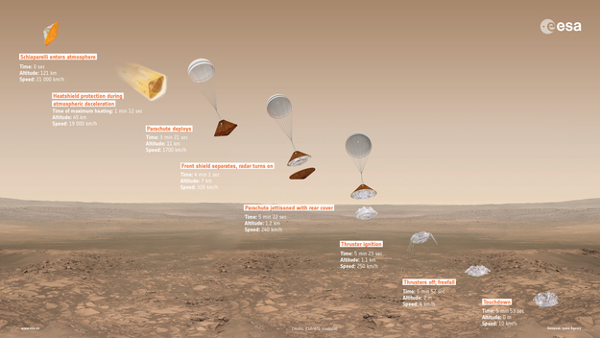Preparing to land on Mars
On 19 October 2016, Schiaparelli – the ExoMars entry, descent and landing demonstrator module – will enter the Martian atmosphere, descend and land on the surface, all within six minutes. The information gathered during this short period will test and demonstrate technologies required to deliver a lander or rover safely onto the surface of Mars.
These technologies include a heat shield, a parachute system, a Doppler radar for altitude and relative velocity measurement, a telemetry, tracking and command system, a liquid propulsion system for attitude control and final braking, and a crushable attenuation system to cushion the landing.
Getting to Mars
Schiaparelli was launched on 14 March 2016, with the ExoMars Trace Gas Orbiter (TGO). The cone-shaped module was attached to the TGO for the seven-month journey to Mars. For most of this trip it has remained in hibernation, while the TGO has provided any required power and communications with Earth.
| ExoMars 2016 separation of Schiaparelli. Credit: ESA/ATG medialab. Click here for video details |
On 16 October, three days before reaching Mars, Schiaparelli will be separated from the TGO by a three-point spin-up and ejection mechanism. Three inclined springs in the mechanism will provide the separation impulse and impart a spin rate of 2.75 rpm. The separation speed will be more than 0.3 m/s (just over 1 km/h). The two craft will then follow separate trajectories en route to Mars.
The TGO, which until then has been on course to deliver Schiaparelli to Mars such that the module will enter the atmosphere at the correct angle, will change trajectory prior to a critical Mars Orbit Insertion manoeuvre that will take place on 19 October.
Meanwhile, Schiaparelli will continue to Mars, rotating slowly around its axis in order to maintain the correct orientation in space for its entry into the planet's atmosphere, with its heat shield facing forward.
During its 3-day coasting to Mars, the module will be in hibernation mode for most of the time to save the energy of its batteries.
One hour before reaching Mars, Schiaparelli will wake up and its on-board computer will be switched on to prepare the craft for atmospheric entry, descent and landing. This will include the start-up of the telecommunication system, the inertial measurement unit, which includes accelerometers and gyroscopes, and the radar doppler altimeter. In addition, the propulsion system that will brake the craft before landing will be prepared by ensuring the correct operating temperature of the equipment and by opening valves to allow the propellant to flow from the tanks to the thrusters. A dedicated Sun sensor on the backshell will be used to recalculate the craft's orientation before it starts the entry and descent phase.
Spacecraft design
Schiaparelli weighs in at 577 kilograms, of which half is accounted for by the surface platform. In total, 46 kilograms of propellant are available for its thrusters. The module's maximum diameter is 2.4 metres and it is 1.8 metres high. The surface platform cocooned inside is 1.7 metres across.
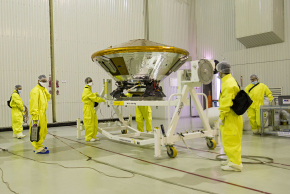 |
 |
| Schiaparelli during launch preparations in Baikonur. Credit: ESA - B. Bethge | Schiaparelli's front shield and backshell. Credit: Airbus Defence and Space SAS 2014 A. Gilbert |
The blunt-nosed module comprises a 47-degree conical backshell and a 70-degree cone-shaped front heat shield. The aeroshell is made of a sandwich structure of carbon-fibre reinforced polymer skins and aluminium honeycomb. The exterior of the module is protected from the cold of empty space during the cruise to Mars by a covering of gold- and silver-coloured multi-layer insulation (MLI), which will be destroyed by the heat generated while entering the Martian atmosphere.
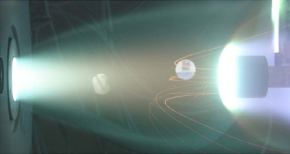 |
| Quantifying the erosion due to dust on Schiaparelli's front shield. Credit: CNES, HPS, DLR |
To survive temperatures reaching up to 1750 degrees Celsius during atmospheric entry, both the backshell and the front shield are coated with a thermal protection layer, although maximum heating takes place at the front of the craft. This 1.5-centimetre thick layer, that encloses the lander completely like a clamshell, comprises about 90 heat-insulating tiles made of Norcoat Liège, a material derived from cork. The thermal coating has also been designed to withstand erosion caused by impacts with tiny dust particles in the Martian atmosphere.
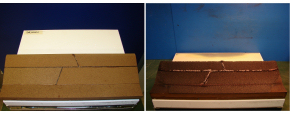 |
|
| Above: Schiaparelli thermal protection system sample before (left) and after (right) plasma wind tunnel tests. Credit: Astrium.
Left: Testing in the high-enthalpy shock tunnel at Göttingen. Credit: DLR. Click here for video details |
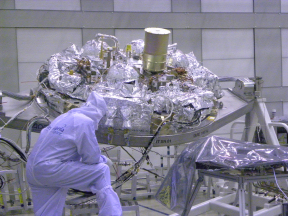 |
| Schiaparelli's surface platform. Credit: Thales Alenia Space |
Protected inside the aeroshell is the surface platform, which carries the main spacecraft systems and electronics, as well as a small science payload that will conduct a number of environmental studies during its short mission on the surface. A parachute system is housed at the apex of the backshell.
Schiaparelli's propulsion system comprises three groups of three thrusters, attached to the outer rim of the surface platform and spaced at 120-degree intervals. The surface platform also carries three spherical hydrazine tanks, each with a capacity of 16 kilograms.
These are linked individually to each thruster cluster but separated from each other to prevent any flow from one tank into another. A single pressure tank filled with helium supplies the gas pressure for feeding fuel to the thrusters. A complex system of valves, and flow and pressure controllers, ensures that each thruster cluster exerts exactly the same force during the final descent phase.
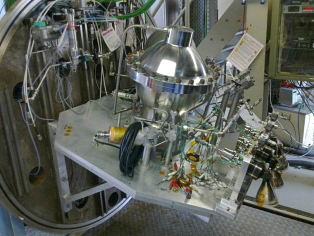 |
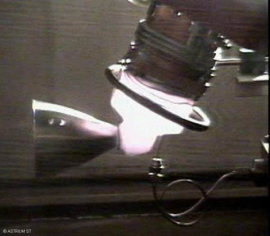 |
| Testing Schiaparelli's propulsion system. Credit: (left) Thales Alenia Space France and (right) Airbus Defense and Space | |
Power is provided by batteries with an operational life of a few Martian days.
Schiaparelli carries a UHF radio system that is used to transmit telemetry data in real time during entry, descent and landing, and later relays the stored data from Schiaparelli on the surface to TGO and other Mars orbiters (when they are visible from the landing site) for forwarding to Earth. Some 100 Mbit of engineering and housekeeping data are expected to be returned, together with 50 Mbit of scientific data.
At the base of the module is a crushable structure made of thick aluminium sandwich panels. This reduces the force of the impact upon landing and is designed to prevent the craft overturning.
| ExoMars EDM landing system drop tests. Credit: SENER. Click here for video details |
Crushable material test. Credit: SENER. Click here for video details |
Descent and landing
When Schiaparelli enters the atmosphere at a height of about 120 km above the planet's surface, it will be travelling at a speed of 5.83 km/s or 21 000 km/h.
Atmospheric drag will slow down the speed of descent drastically, and when it is travelling at about twice the speed of sound, the craft will deploy its 12-m diameter parachute.
The parachute is stored in a bag placed in a "pyrotechnic activated mortar". An explosive charge ejects the parachute bag at supersonic speed, avoiding the danger of entanglement with the craft.
| Schiaparelli's parachute during testing. Click here for video details. Credit: USAF Arnold Engineering Development Complex |
The disk-gap-band design of the canopy, which builds on heritage from the ESA Huygens probe, allows atmospheric gas to escape through a circular spacing in the canopy, reducing initial excess pull and preserving stability during its deployment. The parachute is deployed 27 metres above the spacecraft to minimise any wake effects.
As soon as the module is stabilised beneath the parachute, it will jettison the front shield by means of pyrotechnic electro-explosive devices, a procedure controlled by an on-board timer. This enables the Doppler radar installed beneath the surface platform to begin sending back data on the craft's altitude, as well as its vertical and horizontal velocity.
 |
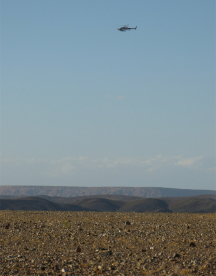 |
| Testing Schiaparelli's Doppler radar. Credit: ESA/O. Bayle | |
These measurements are merged with those obtained with the inertial measurement unit and processed by the on-board computer in order to determine when the powered descent phase should begin.
| Schiaparelli's descent to Mars. Click here for video details. Credit: ESA/ATG medialab |
At an altitude of about 1000 m and a speed of about 70 m/s (252 km/h), the surface platform will separate from the backshell and parachute. Nine CHT-400 hydrazine thrusters (400 Newton thrust each) then begin to fire in pulse modulation – adjusting the pulse duration of each of the nine thrusters – to slow the craft still further and dampen its horizontal and vertical motion.
These shut down 1.5 m above the surface, allowing the craft to simply drop to the ground. This approach ensures that the plumes of the thrusters do not disturb the ground and avoids the possibility of an unstable landing on a rocky surface with the thrusters still functioning.
Impact speed may be around 4 m/s (14 km/h), but the landing is cushioned by a crushable honeycomb structure on the base of the surface platform. The shock absorption layer was selected for its low mass and volume, low cost and simplicity. It also allows the craft to nestle close to the ground.
Schiaparelli carries various engineering sensors to monitor the performance of the spacecraft during the entire entry, descent and landing sequence. Other sensors will measure temperatures, heat flows, and pressures on the front and back shields, orientation and deceleration during flight, and the deceleration of the touchdown.
All these data, stored on board and later relayed to Earth via the TGO, Mars Express, and NASA spacecraft in orbit around Mars, will allow engineers to reconstruct the flight – a key process in optimising the technology and flight procedures to be used in future missions to Mars.

